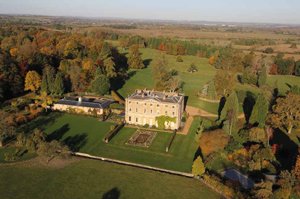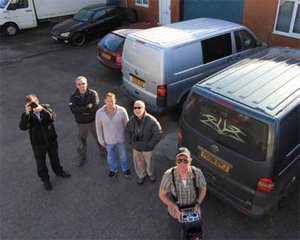articles/Equipment/remote-page4
Remote Control Aerial Platforms - part 4 of 1 2 3 4 5
by Mike McNamee Published 01/12/2012

Any number of applications for showing off high value or historical homes and buildings present themselves as Dave Halton's image shows.
Flying itself is easier than it used to be when all that was available were single rotor 'scale' models of helicopters - the multi-rotor arrangement is far more stable. Even so good piloting skills are essential for effective working and it was noticeable that the machine control from Quadcopters' professional pilots was much better than that we have seen on You-tube clips; they were flying to and from a small folding table with apparent ease! They estimate that most people will need about an hour's flying time to achieve reasonable control, although it is not a given that everybody will be able to master the skills needed - in general the younger generation, used to computer gaming, are more likely to catch on than us oldies! Flying skills will also influence the ability to fly in wind;
as a rough rule an experienced pilot will cope with 20mph wind while a beginner should limit themselves to about 10mph.
The flight stability is impressive; Quadcopters demonstrated flying to a pre-defined GPS location and height, and then slowly rotated to make a panorama of the scene below. The gimbal mount will lock and track a subject even when the airframe is moving around, but stability is vital for smooth filming using video.

Quadcopter pilot Dave Halton snaps McMullin snapping, while McNamee and the Quadcopters team look on.
In terms of capability a well-piloted quadcopter can be flown into a building using first person control although for legal reasons when doing this the control of the airframe has to be under the command of a second pilot who has both line of sight control and overall responsibility for safe flying. Such a system was used to examine the Christchurch Cathedral in New Zealand after the earthquake which devastated the building. After the survey, the building was deemed unsafe for human entry and it was, of course, totally demolished (it is pleasing to report that the rebuild is now underway!) There are other 'high-value' investigations in which airframe safely is not paramount and they are sacrificed in the name of science (or military safety!)
We soon found ourselves daydreaming potential applications. Most of the obvious stuff has been done including weddings, sports events, natural history, coastal erosion mapping, buildings' heat leakage detection, crop studies and general aerial surveys of property and infrastructure. One of the more unusual applications to date was the detection of sheep buried under snow on the fells, using heat-detecting cameras - the use in avalanche rescue and mountain casualty location is an obvious spin-off from this test. Additionally, the ability to fly to exactly the same location time after time has obvious uses in progressive survey work.
Please Note:
There is more than one page for this Article.
You are currently on page 4
- Remote Control Aerial Platforms page 1
- Remote Control Aerial Platforms page 2
- Remote Control Aerial Platforms page 3
- Remote Control Aerial Platforms page 4
- Remote Control Aerial Platforms page 5
1st Published 01/12/2012
last update 21/07/2022 08:46:25
More Equipment Articles
There are 30 days to get ready for The Society of Photographers Convention and Trade Show at The Novotel London West, Hammersmith ...
which starts on Wednesday 14th January 2026










